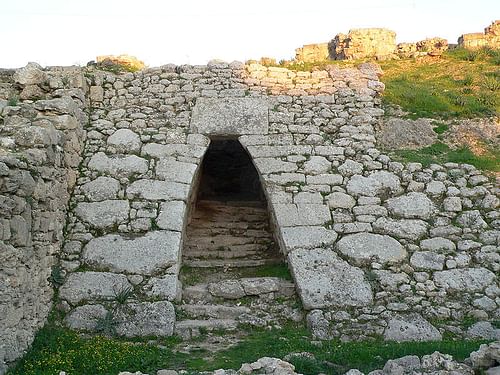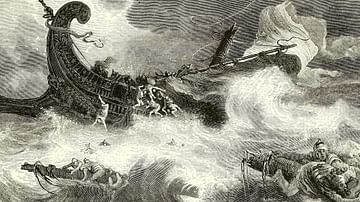
Ugarit was an important sea port city in the Northern Levant. Though never a world power, Ugarit was a key economic center in the Ancient Near East, serving as a major trade center between Egypt and the major powers of Bronze Age Asia Minor and Mesopotamia.
Though Ugarit had been inhabited almost continuously since the Neolithic period (c. 6500 BCE), it was not until c. 1900 BCE that Ugarit begins to establish itself as a major center of trade. The Ugaritic King list (CTU 1.113) and various Ugaritic epics attest to the arrival of a semi-nomadic people from Mesopotamia known as the Amorites around this time. While Ugarit was not a major military or political power, it was an important economic center serving as a bridge between Egypt, Asia Minor, and Mesopotamia. Its success was tied to larger powers in the Ancient Near East. First, the Mari, then Egypt, and finally the Hittite kingdom.
Egypt and the Hittite Empire were most important to the success and prosperity of Ugarit. During the prosperity and stability of the New Kingdom of Egypt (16th to 11th centuries BCE), Ugarit flourished in what is considered the golden age of the kingdom. It seems that most of the epics, which would have been transmitted orally, were first written down during the reign of Niqmaddu II (reigned c. 1350 BCE – 1315 BCE). Despite becoming a vassal nation of the Hittites in the middle of the 14th century BCE and fighting against Ramases II at the Battle of Kadesh, Ugarit remained on generally friendly terms with the Egyptians.
Ugarit's importance was rooted not in its military prowess, but in its political and economic prgamatism. Geographically, Ugarit was perfectly situated to serve as a trade center between Egypt, Mesopotamia, and Cyprus. Ugarit's pragmatism allowed them the exploit this situation.
The earliest recorded treaty found at Ugarit, between Ugarit and Amurru (in modern day Lebanon), illustrates this pragmatism perfectly. Following a military conflict over control of a buffer state which Ugarit lost, a treaty was drawn up where Ugarit was required to pay Amurru a modest sum of 5,000 shekels of silver. Amurru agreed to provide military assistance to Ugarit, but strangely, the agreement was not reciprocal. The small payment, plus the one-sidedness of the military agreement, makes it clear that this was not a vassal paying tribute, but a nation securing an expensive peace rather than a costly war.
When the Hittites made Ugarit a vassal nation in the 14th century, their pragmatism was pushed to the limit and as the power of the Hitties ebbed and flowed, so did the loyality of Ugarit. They extended special treatment to Hittite merchants and provided important military and financial support to the Hittite Empire. Yet, they would not hesitate to exploit moments of weakness among the Hittites and expand their sphere of influence.
Unfortunately, due to the combined pressure of the steady collapse of the palace-temple economy due to the ruralization of the Ugaritic countryside, and the migration of the Sea Peoples from the west, Ugarit, and the empire of their Hittite overlords, collapsed by the middle of the twelfth century BCE.
Discovery & Decipherment of Ugaritic
In 1928 CE, a farmer accidentally uncovered a tomb while working in his field. Upon hearing of the discovery, the Service des Antiquites en Syrie et au Liban sent out an expedition to study the find. While a number of potsherds and unbroken vessels were found, little of promise was contained in the tomb. But while working at the site the French archeologists had their attention drawn by local legend to an artificial mound. The mound turned out to be the tell now known as Ras Shamra.
After a mere five days of digging on the tell, the first cuneiform tablet was unearthed in 1929 CE. This tablet was Akkadian, which was hardly an unsurprising discovery as Akkadian tablets have been discovered all over the Levant and into Egypt (e.g. the Amarna Letters). The Akkadian tablet was similar to that of the Amarna letters leading the team to posit the text dated from the time of Amarna (14th century BCE), but this was shown to be an incorrect theory by subsequent archaeological and epigraphic analysis. These Akkadian letters allowed for the relatively quick identification of the site as Ugarit (a city known from Egyptian and Hittite literature) by 1935 CE, a mere seven years after the initial discovery of the tomb.
Following the Akkadian texts came a number of texts in an unknown language. This language was written in cuneiform, but was quickly identified as alphabetic rather than the expected logo-syllabic (signs representing syllables rather than letters) writing system of Akkadian. The discovery of Akkadian and Hurrian texts written with this new alphabet helped expedite the deciphering of this language; and by 1931 CE, a mere three years after the first text was uncovered, the first full set of values were proposed, though this proposal only had 28 letters, rather than the correct 30. This allowed for the identification of Ugaritic as a Northwest Semitic language, placing it in the same language family as Hebrew, Phoenician, and Aramaic.
Subsequent major digs at Ras Shamra have taken place beginning in the early 1950s CE and concluding in 1976 CE. In 1977 CE, digs began at the neighbouring tell of Ras Ibn Hani, a suburb of Ugarit. A massive number of texts have been found at both sites.
Overview of the Texts of Ugarit
All of the texts found at Ugarit come from the Late Bronze Age (c. 1550 BCE – c. 1200 BCE). Currently eight different languages are attested in texts from Ugarit: Sumerian, Akkadian, Hittite, Luwian, Hurrian, Egyptian, Cypriot-Minoan, and Ugaritic. While five distinctive writing systems were used at Ugarit, the two most common were the Sumero-Akkadian logo-syllabic and Ugaritic. The former was used to write Sumerian, Akkadian, Hittite, and Hurrian. The latter was used to write Ugaritic, Hurrian, and, to a lesser extent, Akkadian. Included among the myriad texts found at Ugarit are a number of bi- and trilingual texts. Despite composing a minority of the corpus, the most famous of the Ugaritic texts are the mythical poetic texts, such as the Baal Cycle, due to the light they shed on the Hebrew Bible.
Found among the texts of Ugarit are the typical Ancient Near Eastern texts such as the Epic of Gilgamesh and the Mesopotamian Flood Story. Yet, there were a number of texts unique to Ugarit discovered. Due to its length, approximately 2350 lines, and relative completeness of the six tablets, the most important text found at Ugarit is the Baal Cycle (CTU 1.1-6).








